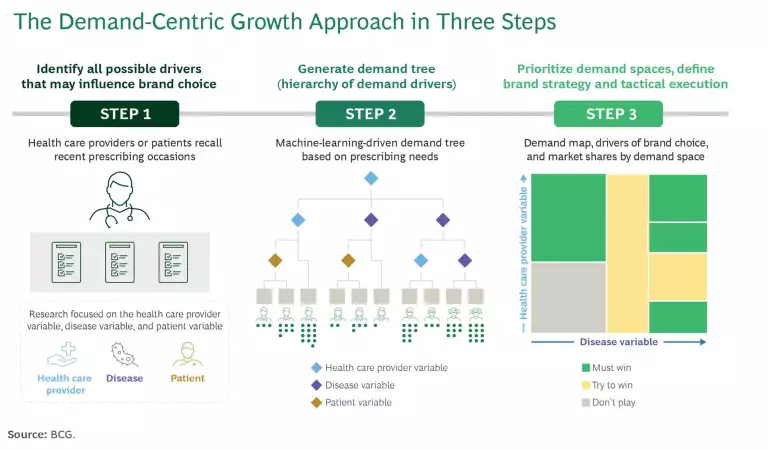Competition within disease states is becoming more intense, making traditional approaches to segmenting patient populations by demographics and broad disease categories much less relevant. Demand-centric growth (DCG) is a proven, data-based methodology that enables brand marketers to identify the most promising sources of growth by integrating patient, physician, and disease-specific context with prescriber needs.
Deconstructing Demand
A prerequisite for any winning brand strategy in biopharma is a deep understanding of the market. At a minimum, you need to know:
- What factors truly drive demand
- Where your brand is winning (and losing) today
- Where are the most promising sources of future growth
Applying the DCG methodology—which has been employed with great success in the consumer goods space for more than a decade—will help deliver the answers and much more. The methodology defines specific, quantifiable demand segments that can be used to inform all elements of pharmaceutical brand strategy.
How Demand-Centric Growth Works
“I can easily come up with 50-plus variables that may influence demand and brand choice, but I have yet to find someone who can explain to me what matters and why,” one pharmaceutical marketing VP told us.
DCG helps brand marketers determine what matters and why, but it goes far beyond just segmenting the market by treatment needs and sizing patient segments based on them to truly understand the shape of demand.
- The first step in the process is to create a robust data set of variables related to the physician, the patient, and the disease across thousands of prescribing decisions.
- In the second step, machine learning algorithms derive the importance of each and every variable in driving prescribing decisions. This helps tease out, in the form of a demand tree, the elusive “why” health care providers make the choices they do.
- In the third and final step, a demand map is created to identify and quantify the most promising patient pools to serve as a source of future growth. (See the exhibit.)

As a result, brand teams have a clear map of the market as it exists today and can identify where to win and how.
Three Success Stories
Applying DCG in the biopharma can create significant value, as exemplified by three success stories from our work with clients.
Post-Launch Acceleration. DCG enabled one large pharmaceutical company to turn around a brand that had struggled postlaunch to achieve 50+% quarterly growth for multiple quarters. The challenge: Despite offering an innovative new drug delivery approach, this product was struggling to find its footing in a large, established market with a broad range of competitors, including both over-the-counter and prescription options across multiple methods of action. The solution: DCG helped the brand team focus on the right efficacy messaging, uncovered specific patient types to target, and determined that focusing on specialists instead of primary care providers would deliver better results. The insights from the DCG process allowed the brand team to adapt its messaging and targeting with high confidence, fundamentally changing its sales trajectory.
Portfolio Co-positioning. At another leading biopharma company, the DCG approach uncovered insights on how to position two distinct assets with some common indications. The DCG methodology defined the demand spaces where each brand was currently competing, as well as the specific demand spaces where each brand was uniquely advantaged. These insights enabled the brand teams to craft differentiated messaging around unique sets of demand spaces that represented 25% of the total market for each brand.
Late Lifecycle Optimization. A prominent pharma company utilized DCG insights to identify growth vectors for a late lifecycle psychiatry product. Prior to DCG, the brand team was experimenting with more than 15 distinct marketing messages to health care providers in its attempt to differentiate the product. After employing DCG, the brand team focused on only three key messages—a decrease of 80%—that truly mattered to providers and differentiated the product. The team was able to rapidly take action based on these new insights, reducing a 150-page interactive visual aid to just 15 pages in less than 6 weeks.
By focusing on what drives demand and helping companies tailor effective strategies accordingly, DCG promises to transform how companies compete and win in this competitive marketplace.











